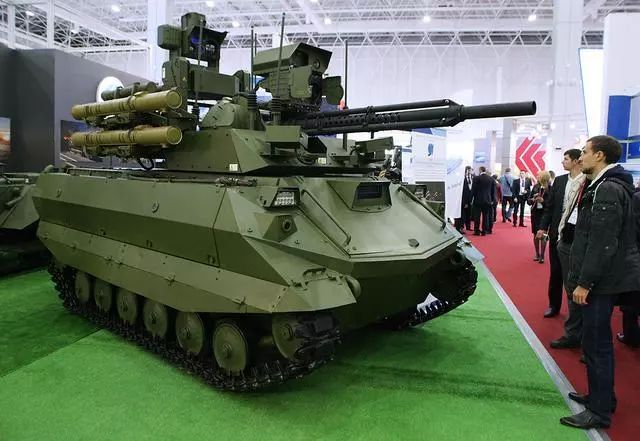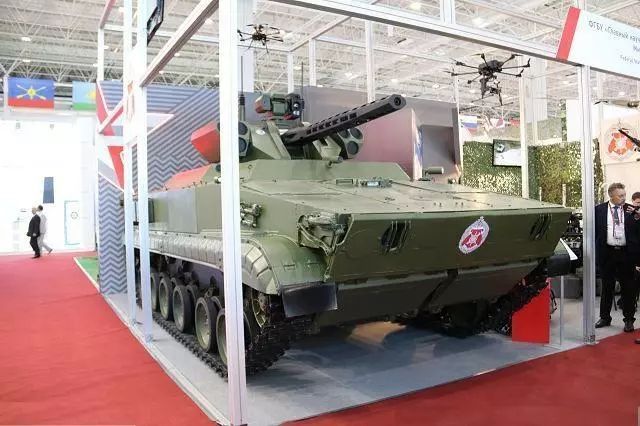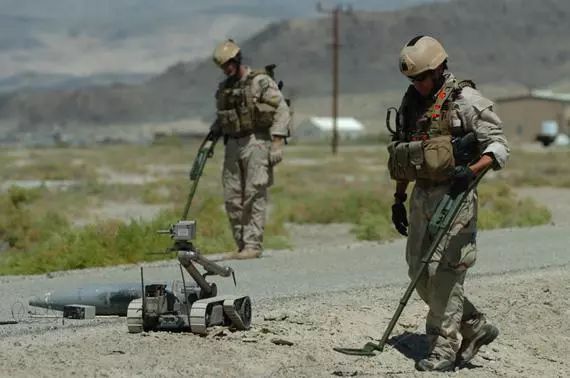Hot news:According to the report of Sputnik news agency & radio, Russia will start to draw up the roadmap of "Robot Force Formation Task" in 2020, and "complete the development and testing of combat robots" in 2025 to form a multi-functional robot force that can independently perform combat tasks. According to sources in the field of Russian defense industry complex, these robot units will be able to achieve maximum automatic control, rarely need manual intervention, and basically complete most of the combat tasks on the battlefield.
Comments:Combat robots have always been an indispensable protagonist in sci-fi war movies, which have brought great shock to the world with their strong firepower system and high operational efficiency. Compared with ordinary soldiers’ flesh and blood, a battle robot with steel bars and iron bones has no defects such as fatigue and fear. It has strong defense ability and also has power beyond human beings, which can effectively reduce the probability and mortality of soldiers directly appearing in the battlefield. It is precisely because of this unique advantage that combat robots have become the focus of all countries in the world and are likely to shine in the future battlefield. However, due to the insurmountable defects of the combat robot itself, after entering the war, some recognized war ethics and legal rules will be challenged and impacted as never before, which must be highly valued and effectively solved.

Russian Uran-9 unmanned combat robot
The formation of combat robot troops is of special significance to the Russian army.
Since the Soviet Union, Russia has spared no effort in battlefield intelligence and made remarkable achievements. For example, during the space race between the United States and the Soviet Union, the "lunar rover" launched by the Soviet Union to the surface of the moon was actually an all-terrain robot with certain autonomy. Nowadays, the security threats facing Russia are extremely complicated, including traditional military confrontation between major powers, realistic operational needs of local conflicts with regional national military forces, and the promotion of "paramilitary tasks" such as anti-terrorism, peacekeeping and riot suppression at home and abroad. If all of them are carried out and completed by people, it will inevitably pose great pressure on Russia’s limited financial resources and troops. In addition, because the population of Russia has been declining for many years and the aging is coming, the number of young people who are suitable for joining the army in China is on the decline, and the problem of military supply is becoming more and more prominent. A large number of combat robots can undoubtedly solve the problem of military supply and expand the size of their own army, so it is of extraordinary significance to establish a combat robot force for Russia.
In recent years, with the continuous recovery of Russia’s comprehensive national strength, the Russian army began to implement a large-scale modernization and upgrading plan for weapons and equipment, and the development of robots that can independently complete battlefield combat tasks has always been the direction of the Russian military and R&D institutions. At present, Russia has developed a variety of combat robots and put them into battlefield practice, and achieved effective military strike results. For example, in the Syrian military operation, the Russian army once invested a robot combat company to participate in the battle, including six "platform -M" tracked combat robots, four "code word" wheeled combat robots, a "acacia" self-propelled artillery group, several drones and a set of "Andromeda -D" accusation system, which formed a combat group. In combat, each robot is responsible for a combat sector, each sector is seamlessly connected, and the firepower covers almost the entire theater. This group of mechanical beasts is fearless of life and death, accurate in shooting and free to move, helping the Syrian army win a great victory. The outstanding performance of these "steel soldiers" also makes Russia have a special liking for combat robots.

Nerekhta, a Russian combat robot, is equipped with large-caliber machine guns and Grenade launchers.
The combat robot unit that Russia is going to set up this time is a new kind of arms. The robot unit is a combat unit and consists of five robots. In this unit, any robot has a high degree of independence, can complete the tasks assigned by the army well according to its own special tasks with the minimum assistance of the operator, and is basically competent for most battlefield combat tasks in conventional wars. The new "beacon" experimental platform equipped with the combat robot team has also been developed and recently unveiled. The platform is a crawler-type platform, equipped with payload function module and UAV cassette launcher module, which can automatically correct the route according to the distribution of obstacles identified by sensors, without the intervention of operators, and can install two sets of weapons with certain firepower. Its biggest feature is that it can carry a robot team to automatically open the route in complex battlefield environments such as dense urban buildings and hilly areas, and realize the task of all-weather and all-terrain operations. According to the plan, the Russian army will complete the scientific research, experimental design and formation of the combat robot force before 2025, and then bring this new type of force into the Russian army’s combat sequence, which will not only change the Russian army’s combat form, but also have a far-reaching impact on the future war mode.
Countries around the world accelerate the pace of robot arms race
As Russia has made great progress in combat robots, it is bound to put some pressure on its United States. The United States is the only country that can compete with Russia in the field of combat robots at this stage, and has been at the forefront of the world in the field of artificial intelligence research. For example, the "power" robot developed by Boston Company in the United States is as flexible as human beings; The "Alpha Dog" developed by Google can transport equipment in complex terrain, while the "bionic fly" robot designed by a team of Washington University can perform some complicated operations that cannot be completed manually, which has laid a good technical foundation for the development of combat robot troops in the United States.
From the perspective of development planning, decision makers in the Pentagon believe that intelligent war robots will flourish in the next 10 years, replacing human beings to complete at least half of the combat tasks on the battlefield, including attacking, protecting and finding targets, and becoming the main fighting force in the future battlefield. Therefore, the United States has invested a lot of money in the research and development and application of combat robots. At present, the US military has "served" at least 10 intelligent war robots in Iraq and Afghanistan, all of which are capable of all-terrain work, and a few are equipped with weapons such as machine guns and Grenade launchers, which can perform combat missions. For example, the robot "sword" deployed by the US military to the battlefield in Iraq can easily pass through any obstacles, and it is equipped with a modified M249 machine gun, with 200 rounds of ammunition, and the firing rate is as high as 1,000 rounds per minute, and the firepower intensity is comparable to that of a heavy machine gun; The "backpack" robot can capture and distinguish the subtle movements of anti-American armed snipers in the street fighting environment. In addition, the "bomb sniffing" robot can sensitively sniff out disguised explosives, thus effectively reducing the casualty rate caused by roadside bombs in the US military.

Vikhr unmanned combat robot developed on the basis of BMP-2 infantry fighting vehicle
In the future, the U.S. military has also put forward a bold plan to form a combat robot force. It is envisaged that the US military will form a brigade-level combat unit in the future, including at least 151 robot soldiers. In order to verify the combat capability of this intelligent war robot team, the United States also held a "robot war exercise": the whole robot combat corps consists of 18 robots performing different tasks, and each robot is connected with various land and air combat platforms and sensors on the battlefield. After the battle started, the ground robot acted as a pioneer. When the hidden enemy attacked it, the unmanned reconnaissance plane in the air found the enemy’s position and informed the unmanned intelligent fighter on patrol, and then the intelligent fighter fired missiles and hit the target. All these tactical actions are completed by intelligent war robots themselves. It is estimated that this robot combat force can shorten the combat time by half and reduce the casualty rate by 60%-80% compared with the traditional soldier force.
It is precisely because of these unique advantages that combat robots have. In addition to the United States and Russia, other countries in the world, such as Britain, Germany, Canada, Japan, and South Korea, are actively developing and preparing to form robot troops. Some of them have begun to use robots instead of soldiers to stand guard, mine and blast, and perform reconnaissance and surveillance tasks. It is expected that in the near future, more countries will devote themselves to the research and development of this new weapon, which will make the whole world slip into the robot arms race unconsciously.
Unmanned will become the mainstream of future operations.
The mode of human war has evolved with the continuous development of military technology. Since the invention of hot weapons, the degree of war damage and casualty rate have risen sharply, especially the tragic situation of Normandy landing during World War II, which is still fresh in many countries’ memories. How to reduce the casualty rate of our own soldiers to the greatest extent has become a factor that must be considered when the country launches a war. In modern warfare, although the application of high technology and the attack of precision weapons have greatly reduced the "face-to-face" mass killing of people in the war, when attacking some strong fortresses or cities, the attacker often has to send a large number of infantry to eliminate the remnants of the enemy. In this case, snipers, mines and machine guns in enemy positions will cause a lot of casualties to the former, so robots are used instead of soldiers to complete fire suppression, surprise attack, defense and defense.

U.S. troops in Afghanistan and unmanned robots perform tasks together.
Judging from the current development situation, although the service of combat robots has not yet formed a scale, and its form and function are constantly being researched and discussed, its embryonic form has basically taken shape, and its "tentacles" have extended to information collection, tactical implementation and strategic implementation. Especially, with the development of the super computing power of artificial intelligence, the combat robot has advantages in the speed and quality of processing information, and can extract effective information from the ocean of data faster and more accurately according to the algorithm, and make the best judgment and decision rationally, thus launching more effective attacks. In addition, when carrying out tactical tasks, the "steel body" of combat robots does not need to reserve space for carrying people. Under the same volume, they can often carry more weapons to enhance their lethality, and they will not affect their judgment and restrict their actions because of various emotions. They can achieve maximum efficiency only by "fearless impact". Therefore, there is no doubt that in the future war, the robot forces will become the absolute main force of combat, and their power will definitely far exceed human power. It will also become extremely possible to replace human beings into the battlefield in a large scale, and unmanned warfare is gradually becoming the mainstream of future combat.
However, we should also realize that with the large number of combat robots, a new type of combat force, some recognized war ethics and legal constraints will also be challenged and impacted as never before. For example, how to abide by the treaty on the protection of prisoners of war stipulated in the law of war? How to avoid the indiscriminate killing of innocent people by robots? If the robot harms civilians, who will be responsible for the main responsibility, the robot itself, the programmer or the battlefield commander? These are all issues that all countries must consider when developing combat robots. Ethical and legal constraints and checks and balances on war are the result of long-term efforts of human society and an important manifestation of human civilization and progress. Fundamentally speaking, the purpose of developing military robots in all countries is to improve their actual combat capability and defense level through technology, protect the achievements of human civilization, and promote the peaceful coexistence of people in all countries. When establishing a combat robot force, we must grasp the methodology oriented to human life and values, fully consider people’s conscience and emotions, and be alert to the potential risks of technology abuse, so as to effectively avoid a series of problems such as ethical disorders, out-of-control security, and legal inaccuracy.
(Bing Tao Zhi Lu is a personal column for the defense column by Ling Yunzhi, a researcher at the Asia-Pacific Development Research Center of Nanjing University. It takes stock of recent major defense events and comments on the hidden mystery behind the information. It will be published every two weeks, and it will be there.)